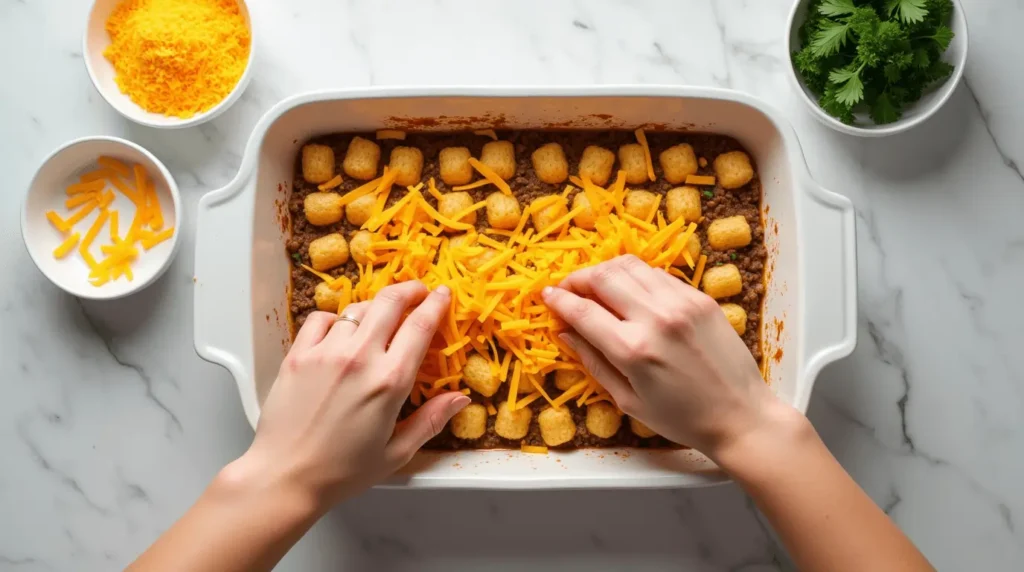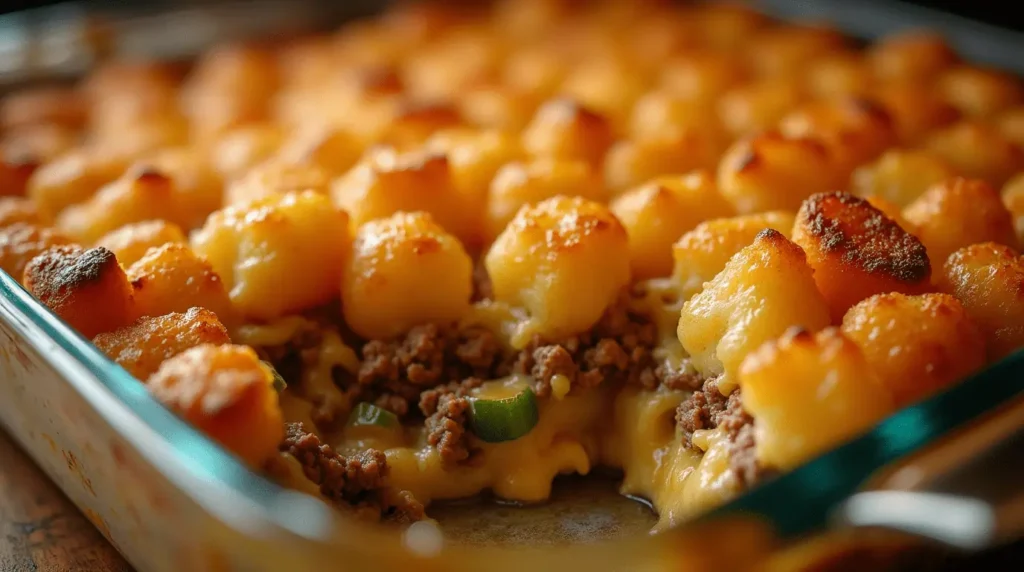Introduction to Rick Nolan’s Hotdish
What Makes Rick Nolan’s Hotdish Special?
Rick Nolan’s hotdish is more than just a meal; it’s a symphony of flavors and textures that epitomize comfort food. This dish stands out for its perfect balance of hearty ingredients layered with care to deliver a satisfying and nostalgic bite. Unlike other casseroles, this recipe is crafted with precision, ensuring every layer contributes to its delightful medley of flavors.
The Cultural and Culinary Significance of Hotdish in the Midwest
Hotdish has long been a cornerstone of Midwestern cuisine. Originating as a practical, one-dish meal during tough economic times, it quickly evolved into a cherished tradition. It’s a staple at potlucks, family gatherings, and community events, symbolizing warmth and togetherness. Rick Nolan’s version takes this tradition to new heights, combining the authenticity of classic hotdish with a refined touch.
A Quick Overview of the Recipe
This hotdish features ground beef, a creamy base, vibrant vegetables, and a crispy topping, all baked to perfection. The beauty of this recipe lies in its simplicity—it’s easy to prepare, yet the result is a dish that feels both indulgent and comforting.
Table of Contents
What Is Rick Nolan’s Hotdish?
Understanding the Concept of a Hotdish
At its core, a hotdish is a casserole, but it’s much more than that in the Midwest. It’s a meal that brings together protein, starch, vegetables, and a creamy sauce, all baked into one cohesive dish. Its beauty lies in its adaptability, allowing home cooks to get creative while sticking to the fundamentals.
Key Features of Rick Nolan’s Version
Rick Nolan’s hotdish is distinguished by its harmonious layering of flavors. The seasoned ground beef forms a robust foundation, the vegetables add vibrancy, and the creamy soup binds it all together. The pièce de résistance? A golden, crispy topping that provides a delightful crunch.
Why It’s a Must-Try for Comfort Food Lovers
This hotdish is the epitome of comfort food. Its rich, savory flavor profile paired with its warm, hearty texture makes it perfect for chilly evenings or family dinners. It’s a dish that invites you to slow down and savor every bite.
The History of Rick Nolan’s Hotdish
The Origins of Hotdish in Midwest Cuisine
Hotdish traces its roots to the early 20th century, when practicality in cooking was paramount. Midwestern families sought nourishing meals that could stretch ingredients and feed many. The casserole concept was born, becoming a culinary emblem of resilience and resourcefulness.
How Rick Nolan’s Recipe Became a Classic
Rick Nolan’s recipe rose to fame for its thoughtful approach to this beloved tradition. By refining the ingredient proportions and enhancing the flavors, he turned a humble dish into a standout meal that continues to be celebrated.
The Evolution of Hotdish Over the Decades
What began as a utilitarian meal has evolved into a canvas for culinary creativity. From classic ground beef and tater tot versions to vegetarian and gourmet variations, the hotdish has adapted to changing tastes while retaining its comforting essence.
Why You’ll Love Rick Nolan’s Hotdish Recipe
Perfect for Family Dinners and Gatherings
Few dishes can bring people together like a hotdish. Its generous servings and crowd-pleasing flavors make it a favorite for any occasion, whether it’s a casual weeknight dinner or a festive gathering.
Easy to Customize for Various Tastes and Diets
One of the most appealing aspects of this dish is its versatility. With a few tweaks, you can tailor it to suit different dietary needs or personal preferences. Add extra veggies, swap in plant-based protein, or experiment with different sauces—the possibilities are endless.
A Nostalgic Dish That Brings People Together
This recipe doesn’t just feed the body; it nourishes the soul. Its familiar flavors evoke memories of home-cooked meals, creating a sense of nostalgia and comfort that’s hard to replicate.
Essential Ingredients for Rick Nolan’s Hotdish
The Core Components for Authenticity
- Ground beef: The savory base.
- Vegetables: Classic choices include peas, carrots, and green beans.
- Creamy soup: Typically cream of mushroom or cream of chicken.
- Tater tots or a crispy topping: For that irresistible crunch.
Optional Ingredients for Personal Touches
- Cheese: Add a gooey, melty layer.
- Herbs and spices: Boost flavor with thyme, paprika, or garlic powder.
- Alternative proteins: Ground turkey or plant-based crumbles.
Substitutions for Gluten-Free, Dairy-Free, or Vegetarian Options
- Opt for a gluten-free cream soup or prepare a homemade version to suit dietary needs.
- Swap dairy cheese for a plant-based alternative.
- Opt for legumes or tofu for a vegetarian twist.
How to Make Rick Nolan’s Hotdish Recipe Step by Step
Preparing the Ingredients: Meat, Vegetables, and Sauce
Begin by browning the ground beef with onions and seasoning. While the meat cooks, chop vegetables and prepare the creamy soup base.

Building the Perfect Layers for Flavor and Texture
Start with the meat, add a layer of vegetables, pour the soup evenly over the top, and finish with a generous layer of tater tots.
Baking and Serving Tips for Best Results
Bake until the topping is golden and crispy. Allow the dish to rest for a few minutes before serving, giving the flavors time to meld and intensify.
Variations and Creative Twists on Rick Nolan’s Hotdish
Modern Takes: Adding Spices, Herbs, or Unique Proteins
While the classic Rick Nolan hotdish recipe is beloved for its simplicity, modern iterations allow for a little more flair. Consider adding bold spices like cumin, smoked paprika, or chili powder to bring an exciting layer of heat. Additionally, swapping out traditional beef for lamb, chicken, or even sausage can infuse the dish with unique flavor profiles that make it truly your own.
Regional Influences and Seasonal Variations
Though hotdish is synonymous with Midwest comfort, it’s not confined to one set of ingredients. In the fall, for instance, roasted butternut squash or pumpkin can be added to the mix for a seasonal twist. In the South, you might find the inclusion of okra or a touch of hot sauce, drawing from the region’s signature ingredients.
How to Adapt for Special Occasions or Holidays
For holidays or special occasions, think about layering in festive ingredients. Cranberries, for example, can be incorporated to add a touch of sweetness during Thanksgiving, or the dish can be made into a more decadent offering by adding a layer of bacon, cream cheese, or even truffle oil. The versatility of the hotdish makes it easy to adapt to whatever the occasion calls for.
Tips for Perfecting Rick Nolan’s Hotdish Recipe
How to Achieve the Perfect Texture and Flavor
The key to a flawless hotdish lies in achieving the perfect balance of textures. The meat should be cooked until just browned, so it maintains its moisture and tenderness. For the vegetables, it’s crucial to slightly cook them beforehand to ensure they soften up during baking without becoming mushy. The topping should be crisp and golden, so don’t skip that last few minutes of baking time to ensure the crunch.
Seasoning Secrets for a Delicious Hotdish
Seasoning is essential to elevate the dish. A mix of salt, pepper, garlic powder, and onion powder can enhance the richness of the beef. Adding a pinch of cayenne pepper or a dash of Worcestershire sauce will deepen the flavor and add a subtle complexity that balances the creamy base. For those who like a bit of zest, a squeeze of lemon or a dash of hot sauce before serving can make all the difference.
Common Mistakes to Avoid
One common mistake is overcooking the topping. If you bake the hotdish for too long, the tater tots can become overly browned or even burnt, losing their crispiness. Another mistake is not allowing the dish to rest after baking—this gives the layers time to settle and makes it easier to serve. Lastly, don’t skimp on the seasoning; a bland hotdish will leave eaters underwhelmed.

Tips for Storing, Reheating, and Freezing Hotdish
How to Store Leftovers Without Losing Flavor
Store leftover hotdish in an airtight container and place it in the fridge. It will stay fresh for up to three days. To preserve its flavors, make sure the hotdish is completely cooled before storing, as this prevents moisture from affecting the texture of the topping.
Reheating Techniques for Maintaining Texture
To reheat hotdish, place it in the oven at 350°F for 15 to 20 minutes. This will help crisp up the topping while warming the rest of the dish. Alternatively, you can microwave individual servings, but be sure to cover them with a damp paper towel to avoid drying out the dish.
Best Practices for Freezing and Long-Term Storage
Hotdish can be frozen for up to three months. To freeze, allow the dish to cool completely, then wrap it tightly in plastic wrap and aluminum foil. When ready to serve, thaw the dish in the refrigerator overnight, then bake at 350°F for 25 to 30 minutes to restore the crispy topping.

Rick Nolan Hotdish Recipe
Equipment
- Casserole dish (notes: 9×13-inch)
- Mixing bowl (notes: large)
- Skillet (notes: for browning beef)
Ingredients
- 1 lb ground beef
- 1 small onion, diced
- 1 cup frozen mixed vegetables (peas, carrots, green beans)
- 1 can (10.5 oz) cream of mushroom soup
- 1 cup milk
- 1 cup shredded cheddar cheese (optional)
- 1 bag (32 oz) frozen tater tots
- Salt and pepper to taste
Instructions
- Preheat oven to 350°F (175°C).
- In a skillet, cook the ground beef and diced onion over medium heat until browned. Drain any excess fat.
- Stir in the mixed vegetables and cook for another 2-3 minutes.
- In a separate bowl, combine the cream of mushroom soup and milk, then pour over the beef and vegetable mixture. Stir until well combined.
- Season with salt and pepper to taste.
- Spread the beef mixture evenly in a large casserole dish.
- Top with frozen tater tots, covering the entire surface.
- Bake for 40-45 minutes, or until the tater tots are golden brown and crispy.
- Optional: For a crispier topping, sprinkle breadcrumbs over the hotdish 10 minutes before finishing.
Notes
- Customization Tips: Swap the ground beef for turkey or a vegetarian protein for a healthier option.
- Make-Ahead Instructions: Prepare the hotdish the night before, cover, and refrigerate. Bake the next day at 350°F for 40-45 minutes.
Frequently Asked Questions About Rick Nolan’s Hotdish
What Sets Rick Nolan’s Recipe Apart from Others?
Rick Nolan’s hotdish is distinguished by its attention to balance—each ingredient is carefully selected and portioned to create a harmonious blend of flavors and textures. The use of quality seasonings and the creamy soup base that ties everything together elevates the dish, giving it a sophistication that other versions may lack.
Can I Make It Ahead of Time?
Yes, this recipe is ideal for making ahead of time. Prepare the hotdish the night before and store it in the refrigerator until you’re ready to bake. This allows the flavors to meld and creates a more flavorful dish when baked. Just make sure to adjust the baking time if the dish is cold from the fridge.
How can I modify the recipe to serve a large group?
Scaling up the recipe for a crowd is simple. Simply adjust the ingredient quantities based on the number of servings needed and use a larger casserole dish. Extend the baking time slightly, as larger quantities will take longer to cook evenly.
Are There Any Low-Calorie Versions of This Dish?
To make a lighter version of Rick Nolan’s hotdish, consider swapping in lean ground turkey or chicken, using reduced-fat cream soup, or omitting the tater tots for a healthier topping option like whole-grain breadcrumbs. You can also add extra vegetables to increase the nutritional value without compromising the overall flavor.
Conclusion
Final Thoughts on Rick Nolan’s Hotdish Recipe
Rick Nolan’s hotdish recipe is a timeless, comforting dish that embodies the spirit of Midwest cooking. With its rich layers of flavor, customizable components, and versatility, it’s a dish that appeals to a wide range of palates. Whether served at a casual dinner or as a holiday centerpiece, it never fails to impress.
Why This Dish Is a Staple in Midwest Kitchens
The hotdish has been a beloved part of Midwestern culinary tradition for generations. It’s a dish that brings families and communities together, offering sustenance, a sense of home, and shared history.
Encouragement to Share the Recipe and Experiment
Don’t be afraid to make Rick Nolan’s hotdish your experiment with different ingredients, seasoning combinations, and toppings. The beauty of this dish is that it can evolve while still honoring its roots. Share it with loved ones, and let it become a new tradition in your kitchen.


Thank you so much I love it